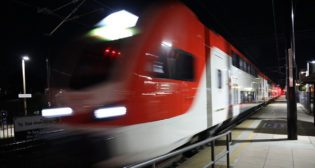
Is Texas High-Speed Rail Ready for Construction?
Written by Marybeth Luczak, Executive Editor
The proposed $20 billion, 240-mile rail line connecting Dallas (potential station pictured) and Houston has completed key regulatory processes.
Private high-speed rail developer Texas Central is another step closer to starting construction of a $20 billion, 240-mile line connecting Dallas and Houston. The Federal Railroad Administration (FRA) has released the final Rule of Particular Applicability (RPA) and Record of Decision (ROD) that establish federal safety standards for operation and give environmental clearance for the selected alignment, respectively.
“This is the moment we have been working toward,” Texas Central Railroad CEO Carlos Aguilar said. (Texas Central Railroad is the operating subsidiary of Texas Central.)
The RPA establishes comprehensive safety requirements governing signal and trainset control, track, rolling stock, operating rules and practices, system qualifications, and maintenance. According to Texas Central, it is based on a systems approach to safety, incorporating accident avoidance measures that are “significantly more stringent than those required for conventional U.S. rail operations.”

The Texas high-speed rail system is slated to replicate the Japanese Tokaido Shinkansen system, which is operated by Central Japan Railway Co. (JRC) and has transported more than 10 billion riders throughout its 55-plus year history with zero operational passenger fatalities and zero accidents.
According to the FRA, the “regulation was written specifically for this technology to maintain the integrity of the baseline safety case” of JRC’s Tokaido Shinkansen, and establishes “regulatory requirements codifying the service-proven technological, operational, and maintenance aspects of the Tokaido Shinkansen HSR system.”
The ROD completes the FRA’s environmental review process, which began in 2014 as required by the National Environmental Policy Act and culminated with the publication of the Final Environmental Impact Statement that was released on May 29. It also formally selects the alignment that Texas Central Railroad will follow (Build Alternative A, pictured below).

FRA analyzed six end-to-end build alternatives as well as a no-build alternative.
Riders will be able to travel between Dallas and Houston—with an intermediate station west of Roans Prairie in Grimes County—on a dedicated right-of-way in less than 90 minutes. The train will have a maximum speed of 205 mph.
“The momentum toward construction is building every day,” Texas Central told Railway Age. “At this time, we anticipate construction starting in the first half of 2021. Engineers, architects and environmental experts are working on many fronts, including infrastructure, engineering and design; development of world-leading safety practices; design of the interior of the trains; and the rider experience.” A testing and commissioning period is expected to follow in 2025, with service starting in 2026.
Texas Central Railroad Partners
In September 2019, Texas Central signed a design-build contract with the Webuild Group (formerly known as Salini Impregilo) and its U.S. subsidiary and joint-venture partner Lane Construction. They will provide civil infrastructure work, including design and construction of the viaduct and embankment sections along the entire route; installation of the track system; and construction of related buildings and services that will house maintenance and other rail system equipment.
Also selected for the project: Bechtel (rail program manager); JRC (technology provider) and Spain-based Renfe (system operator); Team Shinkansen United (Hitachi, Mitsubishi Heavy Industries, Toshiba, NEC and JRC) will supply high-speed rail technology; Kiewit (Nebraska) and Mass Electric Construction Co. (Massachusetts) will install the core systems that will operate the train, in partnership with the International Brotherhood of Electrical Workers; and Matthews Southwest (a Texas-based real estate developer) and Suffolk Construction (Massachusetts) will develop and build the Texas Central stations.
Financing Under Review
Now that the RPA and ROD have been released, Texas Central “is focused on securing funding, followed by the start of physical construction,” the company told Railway Age. “Texas Central Railroad has already secured letters of intent from banks in Japan and Europe, reflecting the financial viability of the project, and now is working toward achieving formal commitments from these entities, as well as others in the United States.”
Carlos Aguilar told Railway Age sister magazine International Railway Journal (IRJ) in April: “Once we receive our permit approval, our ability to begin construction will be contingent upon financial entities in the U.S., Europe and Japan, all of which are dealing with urgent priorities generated by COVID-19, completing their due diligence process. Like other companies and organizations around the world, we are trying to make the best use of the funding we currently have, paying close attention to COVID-19 updates and putting plans in place to move our project forward as soon as the world is on the other side of this uncharted territory.”
Texas Central expects to create more than 17,000 jobs during construction and have a multibillion-dollar economic impact across the U.S. But on March 27, the company laid off nearly 30 employees. Aguilar told IRJ that the staff reduction was “an effort to make the best use of our current funding … We still do not know what other impacts this will have.”



